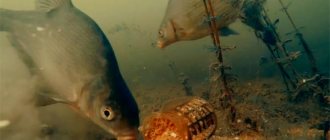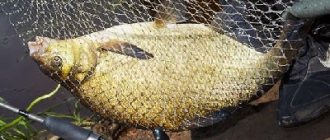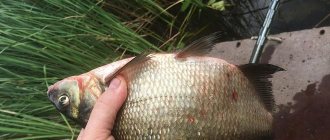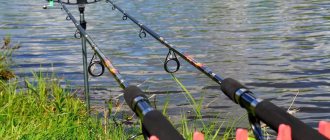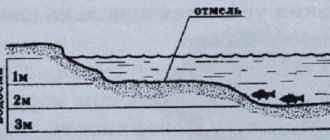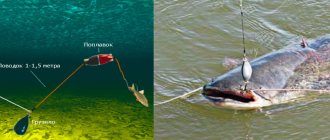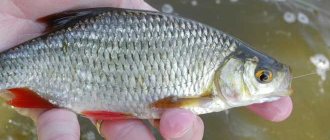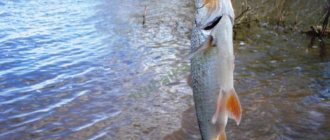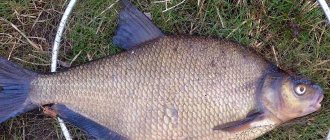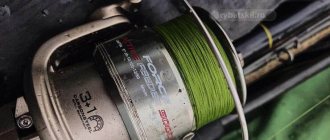Features of bream fishing
Breamers enjoy well-deserved prestige among fishermen.
Catching a large bream is quite difficult. Bream fishes well in the evening, before sunset or at dawn. It is very difficult to catch bream during the daytime. And the largest specimens are found exclusively at night. If there is a slight wind and a strong wave, the bream can bite well in broad daylight.
Large breams try to stay away from the coastline. They stay close to the fairway. You can also find real bream fishermen there.
Whatever the bait is, it is important to remember that it is necessary only to whet the appetite; it is important not to overfeed.
The bait should be less attractive than the bait. Bream begins to take the bait at the end of April.
After hibernation and until spawning, the bream bite is very good. Before spawning, bream travel in schools near the shore. Bream feeds in a vertical position. Worms, Bloodworms or Maggots are used as bait for catching bream.
New generation fishing - Bream fishing on the river (Video)
Bream fishing in summer
In the summer months, especially from mid-July to the end of August, practically no bream is caught. However, after the algae harden, the bite will resume again and will last until the end of October.
Then the bream gathers in schools and lies down for the winter in the deepest holes. In July, bream is usually found on the fairway in deep places, and only at night or in bad weather does it come closer to the shore.
In the late afternoon, a fisherman can spot bream near the shore by air bubbles rising from the bottom. Bream, when compared with perch, does not react to a fast-moving jig, but takes it when it moves on the bottom.
Bream loves to eat well, so it goes to where the food is constantly lying. In closed reservoirs, bream usually changes its sites, but always stops at feeding places.
This cunning and cautious fish begins to be fed in its favorite place for 5-7 days. It is best to place the bait at a depth of up to 3 meters. Bream are afraid to approach small places, and small fry can take away the bait.
Best Bait for Bream Fishing
The most attractive baits for bream are bunches of dung worms and bloodworms, as well as blizzard larvae, maggots.
Egg-kneaded dough, steamed peas, and semolina dough are also suitable.
On hook No. 5, lumps of dough should be sculpted in the shape of a pear. Maggots or worms are placed on the hook in clusters or in a lump. The hook must be completely hidden, because bream even smells metal.
The rod itself should be elastic and flexible. The nozzle should be located at the bottom. The bite can always be identified. The flat bream stands on its head and sucks up the bait along with the water. The float sinks into the water and after a while sinks.
On what Factors does the Bream Bite Duration depend?
According to the observations of ichthyologists, in deep places, where the sun penetrates later, the bream begins to bite later. The same applies to reservoirs with muddy and clear water.
The quality of the bait also affects the bite. The more caloric the bait, the faster the bream satisfies its hunger. The fish does not swallow the bait, but takes it with its lips, so too protruding hooks cannot hook the fish.
Catching bream with a ring. Program 214 (Video)
Recommendations
Before you begin testing the presented methods, you need to consider some important aspects:
- For all methods, with the exception of bunching, a special hook for bloodworms is used. It is made of thin wire, the diameter of which allows installation without serious damage to the body.
- It is better to use selected bloodworms that are bright red in color and actively move. The bite on such bait will be much better.
- The bait is replaced after each bite or every 10-15 minutes. This will keep the fish interested and get a good result from the effort spent.
- single;
- beam
When purchasing bait, you need to pay attention to its color - it should not be brown, this indicates the unsatisfactory condition of the product. Most likely, the bloodworm will not live to see fishing or will stop showing signs of activity in the first hour of fishing.
"Stocking". Outwardly, it is a very simple method in which a worm is usually attached. And most importantly, with such a bait, the fish has practically no chance of leaving after biting. But it’s not easy to pierce a bloodworm from head to tail without some skill.
Bloodworms are the most popular bait, after worms and maggots, for amateur and sport fishing, especially in winter from the ice. But if, as a rule, even novice fishermen do not have any problems with attaching a worm, then with bloodworms the matter is more complicated. It is very thin and breaks and leaks easily.
There are 2 types of mounting:
8 mounting methods
"Ring". This method of baiting is used when the fish bite is sluggish and rare, when each bite has a special price. The bloodworm is pierced in the head part, and then launched into the tip of the tail, so that the bloodworm forms a ring with a “moving” head. The fish is practically unable to rip off such a bait.
"Stocking". Outwardly, it is a very simple method in which a worm is usually attached. And most importantly, with such a bait, the fish has practically no chance of leaving after biting. But it’s not easy to pierce a bloodworm from head to tail without some skill.
Sports way . During very active biting or in competitions, when minutes count, the bloodworm is pierced along the body of the larvae with a hook approximately in the middle, and then the hook is brought out towards the head or tail. Sometimes they do it even simpler: they string several larvae with the sting of a hook according to the principle “just to hold on.”
Placing bloodworms in a bunch. Variations of this method are used when catching large fish and using fairly large hooks. Previously (and often now) bloodworms were tied into a bundle of 8-10 larvae with a simple thread, which was then pinned onto a hook or jig. But working with thread, especially in the cold, is not very convenient. Therefore, other devices began to be used for knitting.
Tying a bunch of bloodworms with nipple rubber. A cut is made on the plastic rod of a gel fountain pen with a diameter of 0.5-0.8 cm, which turns one of its ends into a small scoop. On the other side, cut rings made of nipple rubber are put on the rod. We scoop out the bloodworm with a scoop, and then lower the elastic band onto the resulting bunch. Such ready-made bundles are then simply hooked onto the shank of the hook.
Tying a bunch of bloodworms with a bunch knitting machine . The bundle tie is a special device that is produced industrially and sold in fishing stores. A device with special legs that stretch the elastic band collects a handful of bloodworms, and then the elastic band moves and clamps the bundle with the hook.
Placing a bunch of bloodworms on clothespin hooks . Such hooks, sold in fishing stores, have a double profile (parallel shank), but one sting. A special loop opens this profile and, after collecting a bunch of bloodworms, compresses it again.
[THERE IS AN ANSWER] How to make a feeder for catching bream
Knots for tying a leash to a fishing line - used in both feeder, float and spinning fishing.
How to choose the right fishing line for fishing - a guide to comparing monofilament, braid and fluorocarbon.Hook knots - rating of the strongest.
Knowledge of the rules and methods of attaching such popular baits as bloodworms and maggots will help fishermen, especially beginners, quickly improve their skills and... catches.
When the bite is sluggish (and this means often), it is desirable that the maggot remains alive, and even retains its agility. This provokes fish better than a motionless dead larva. But the maggot can retain its vitality provided that its insides are not damaged by the hook. Therefore, the classic recommendation for baiting a maggot looks like this: - use the tip of a hook to pry the skin near the head between the so-called “eyes”, then bring the sting out under the skin and move the maggot towards the forearm.
Even experienced fishermen do not know exactly how best to place a bloodworm or maggot on a hook, so that on the next cast the fish will finally stop resting and start catching.
The question “how to best place bait on a hook” is one of thousands among experienced fishermen, in the context of their constant search for secret techniques for successful fishing. And for beginner fishing enthusiasts, this question is direct and essential - really, how to properly attach a bloodworm or maggot to a hook?
Place the bloodworm on the hook
The usual recommendations for planting bloodworms are as follows.
- Only extremely thin “crank” hooks are used. You shouldn’t even try to pull a moth onto a “carpokiller” hook.
- Bloodworms are selected before baiting. The largest larvae with the most pronounced fighting qualities are used. It bites much better on a moving larva.
- We replace the bloodworm on the hook with a fresh one in time. Then you can get the most from the reservoir.
Hanging
One bloodworm is taken with the fingers of one hand (be careful not to crush it). The hook is taken with the other hand. The bloodworm is then pierced with a sting approximately between 3 and 4 segments from its head. The hook is removed from the larva near the head itself, and it moves to the bend of the hook. That's all - the living creatures do not lose their vitality for a long time (about 15 minutes) and remain attractive to fish.
According to some anglers, the attractiveness of the bait will increase if a pair or three larvae are attached to the hook in a similar way. This is especially true when it comes to catching heavy fish.
A bloodworm hanging from a hook is good when the fish is moderately active and will greedily grab it, swallowing it along with the hook. But this rarely happens. Much more often, the fish carefully takes the mosquito larva by the tail and pulls it off the hook, leaving the angler with only empty hooks over and over again.
Stocking
With the weak, the method of baiting bloodworms with a “stocking” helps. It's easy to do. In the same way, the larva is pierced near the head, only this time the sting is directed towards its tail. With careful movements of the fingers, it is pulled onto the hook. Tail droop is minimized as much as possible, but the hook is not removed from the body. Now the fish has nothing special to pull off the larva, and it captures it immediately along with the hook.
Accidentally hitting
Everything is not bad, but such actions require a lot of time and sleight of hand. But what to do in a situation when the fish is really hungry and every second counts? Or when in the cold your fingers are hard to control? Or in a situation where your hands are shaking and you can’t even see one bloodworm? Then the method of attaching a bloodworm to the rescue comes to the rescue.
The bloodworm ball is grabbed with two fingers. Then, the hook is pierced several times through the entire ball, and within a second, one or several bloodworms or parts of them are somehow picked up on it. And such a bait is sent into the water (under the ice), and with a passionate bite, the fish are caught no worse than if the fisherman very diligently put on the bloodworm for several minutes and examined the results of his work.
Big bunch - big catch
To catch large fish, anglers sometimes use a whole bunch of bloodworms tied to a hook. For example, this is often done when fishing for bream. A small piece of nipple elastic will help secure the bunch of bloodworms to the hook. When fishing, the entire bunch is planted in seconds - just insert the sting into the nipple, which already contains several bloodworms. And the thickness of the hook now does not play any role, which is a big plus for catching large fish.
But how to thread a bloodworm into a nipple, and even a whole bunch?
How to thread a bloodworm through an elastic band
The simplest device that every angler can make with his own hands will help. Take a plastic handle and throw out all the guts. The body is cut with a knife “on an oblique”, so that at its cut end something in the form of a scoop with a pointed nose is formed. Then a short piece of elastic is pulled onto this body through its sharp part. Several bloodworms are placed on the scoop, and the nipple is pulled off the handle, simultaneously capturing all the bloodworms located “in the scoop.”
Having spent half an hour at home preparing the bunches and n-number of elastic bands, the fisherman will come to the pond, as they say, fully armed. By the way, the nipple, after the bloodworm is eaten by the fish, can be used for the second pass.
If bloodworms can be planted in any way you like - “as it turns out” or as your imagination dictates, and at the same time, not without reason to count on a bite, then with maggots the situation is somewhat more complicated. One circumstance adds special features to its use - this larva has a very hard and durable skin.
Live maggot
When the bite is sluggish (and this means often), it is desirable that the maggot remains alive, and even retains its agility. This provokes fish better than a motionless dead larva. But the maggot can retain its vitality provided that its insides are not damaged by the hook. Therefore, the classic recommendation for baiting a maggot looks like this: - use the tip of a hook to pry the skin near the head between the so-called “eyes”, then bring the sting out under the skin and move the maggot towards the forearm.
This way you can plant several maggots to catch large fish. After biting (catching a fish), it often happens that the maggot on the hook remains intact, alive and fidgety, and is suitable for re-casting.
Baiting options
A maggot can very easily take revenge on a fisherman for being hooked to be eaten by fish. It wraps itself around the hook and simply covers the sting with its body. Further: - the fish bites, the float quickly moves away to the side with a dive, the fisherman even waits to spot the carp (whale) for sure, aaaand... and on the hook there is only a smiling maggot.
If the larva covers the sting with its hard skin, then it will not be possible to hook the fish. Therefore, when the bite is confident, fishermen bait the maggot with a stocking, after which it quickly dies. Or, many fishermen recommend doing a combination of baiting techniques - a couple of larvae are put under the skin to keep them alive, and then a maggot pierced through its length is placed near the sting.
Whenever baited, the hook tip is always removed from the body of the blowfly larva, and remains free for hooking fish.
[THERE IS AN ANSWER] How to cook semolina for bream fishing
How to make larvae immobile
Sometimes, for conditions of confident biting on bait, or when there is not enough time at competitions, anglers specially use killed larvae so that they do not interfere with the bait with their fidgetiness and do not make idle hooks. Maggots are killed with heat. In order not to cook it over a fire, the larvae are first cooled (spring water), then immediately placed in hot water (tea from a thermos). After this procedure, the fisherman confidently throws maggots on a hook towards the ever-hungry mouth of the long-awaited carp.
In this video, Alexander Serykh, representative of the Novosibirsk region team at the Russian Ice Fishing Championship, will show these bait methods and tell you when he uses them.
Have you often encountered the fact that there is a fish on the hole, even reacting to the bait, but you just can’t catch it? Bite after bite, and all the hooks are empty. Has it happened?
Often, this happens due to the size of the jig itself or the size of the hook. If the jig is too large for the fish that reacts to it with empty bites, it makes sense to reduce its size. A smaller jig, made of the same material and on a fishing line of the same diameter, will give the bait a smooth fall and allow the fish to suck itself in with less effort. The number of successful bites will increase.
Did you know that the main reason for empty bites when fishing with bloodworms is the wrong attachment on the hook? Incorrectly placed bloodworms often lead to the fact that when there are many fish bites, we only get one or two out of the hole.
“The correct method of attaching a bloodworm to a hook is one in which the number of empty bites is minimal”
Below, we will show 5 types of attachments for one bloodworm. Note that all 5 methods will be both correct and incorrect at the same time, since the appropriate method is always selected for the fish you are catching. That is, at the fishing site.
But first, let's look at the bloodworm and denote the following:
- The bloodworm has a head and a tail
- The head part is dark, the tail part has a forked tail.
- The bloodworm is divided into segments (“sections”)
The structure of this larva is more complex, but that’s all you need to know in order to place it on a hook without any problems.
Attaching a bloodworm to the head
This method is searchable and popular. It takes a minimum of time to attach a bloodworm to the head, so sports fishermen often start searching for fish with this method.
By placing a bloodworm behind the head, we get the most active game, since most of it remains in a mobile state. Along with the game of the jig, the bloodworm also plays. As a rule, this fact has a positive effect if there are active fish in the fishing area.
But we also consider the long overhang of the bloodworm to be a disadvantage of this type of bait. If the fish is inactive and is not in the mood to greedily grab the bait, it will more often “pinch” the tip of the bloodworm, and empty hooks will begin.
To place the bloodworm behind the head, we retreat two or three “sections” of the head part of the bloodworm and pierce it. It's simple!
Bloodworm attachment with a ring
This method appeared as a simple solution to the problem of empty bites when baited behind the head. We took the bait out of the water, put the tail on the sting and continued fishing. Often this is enough to get rid of empty hooks.
When attaching a bloodworm with a ring, the resistance of the bait increases, due to which the fall becomes a little longer. You may hardly notice it, but the fish will most likely take notice. When catching passive fish on a drop, this bait method often bears fruit.
To put a ring on the bloodworm, we retreat two or three “sections” of the head part and place it on the hook. Now we retreat two or three “sections” of the tail section and pierce them.
Attaching a bloodworm with a stocking
It happens that a cautious roach is alarmed by the hook, which is visible when using the methods described in the first two cases. The fish both wants to eat our bait and is afraid. This method of attaching bloodworms solves this problem.
Attaching a bloodworm with a stocking reduces the volume of the bait, which can also have a positive effect in the presence of empty bites. The fall becomes a little faster.
To attach a bloodworm with a stocking, enter the sting into the center of the head of the bloodworm and bring it to the middle (closer or further, depending on the size of the larva and the size of the forearm), without moving the sting out.
Attaching the bloodworm with a stocking “in reverse”
This is an extremely rare case, and not everyone will be able to identify it, but the fish can be so wary that they can feel the sting of the hook while tasting the bait. In this case, frightened, she leaves the bait.
This is how the method of attaching bloodworms with a stocking “in reverse” appeared. In this case, the remaining dangle of the bloodworm is not at the sting, but on the reverse side. Thus, a cautious fish sucks on a bloodworm and, without being pricked, sucks in the bait entirely.
Note that for both methods of baiting with a stocking, only jigs with a sharp sting and a thin hook wire are suitable.
To attach a bloodworm with a stocking “in reverse”, enter the sting into the middle part of the bloodworm and bring it to the head part, without moving the sting out. Ready!
Bloodworm attachment with a puncture in the middle
This method is the second most popular after the head attachment. It is also simple and requires minimal time and effort.
When attaching a bloodworm with a puncture in the middle, we get two playing parts of the bloodworm. It is important that both overhangs are not as long as in the first case described in the article. Thus, the bloodworm plays at a high frequency.
To plant a bloodworm this way, visually divide the larva in half and pierce it in the middle.
5 ways to attach bloodworms VIDEO
In this video, Alexander Serykh, representative of the Novosibirsk region team at the Russian Ice Fishing Championship, will show these bait methods and tell you when he uses them.
No matter how simple this information is for you, do you remember it while fishing? After all, it is these simple truths that can often significantly increase your catch.
Find the right approach to the fish. Use a variety of bait presentations and experiment with bloodworm baits. There will definitely be a result.
- pressed to the shank of the hook
The bloodworm is a worm up to 13 mm long, mostly red, but sometimes greenish. It is the larva of the long-lasting mosquito and lives in the bottom silt of ponds, lakes, and river creeks. The bloodworm lives in the water for some time, and then it pupates and turns into a mosquito. Bloodworms are an excellent bait; they are used both in winter and summer, but more often in winter. A large bloodworm is placed on a hook, and a small one is used to bait fish.
You can attach bloodworms to a hook in the following ways:
1) The bloodworm can be put on the hook with a “stocking”, the sting is inserted through the “tail”. The bloodworm dies immediately.
What is the advantage of this method? - you can hide the sting of the hook.
Minus - unfortunately, one bloodworm cannot attract larger fish, and for baiting with a “stocking” only a large bloodworm is required, the middle one is no longer suitable.
2) In my opinion, the best way to attach bloodworms is with a “brush”. In this case, the sting of the hook is used to pierce the bloodworm’s body just below its black head. The bloodworm also dies almost immediately, but still remains more attractive to fish than if baited with a “stocking”. You can plant one bloodworm or several. For example, 5-8 larvae are planted for bream, 2-3 for perch, and 1 bloodworm for roach in the middle of nowhere.
Pros - it is possible to plant several larvae, which attracts large fish. The bloodworm can also bend and look natural.
Disadvantages - the free tail of the bloodworm likes to suck small things, in the end it may turn out that the small fish simply sucks out the bloodworm and only the less attractive translucent skin remains.
3) This method of mounting may be useful. The bloodworm is not placed on the hook, but placed between the fishing line and the body of the jig or the shank of the hook (if it is a bare hook). Under the weight of the fishing line, the bloodworm is pressed against the body of the jig.
- pressed to the shank of the hook
- pressed to the body of the jig
Plus - the bloodworm does not die immediately, it still moves for some time, which additionally attracts fish.
The disadvantage of this type of attachment is that the bloodworm is not very securely fastened and small fish easily and quickly poke it. Where there are a lot of small things, this method of attaching bloodworms will not be useful.
Perhaps that’s all, although I know of another way to attach bloodworms. Its essence is similar to method No. 3. Bloodworms are also not pierced with a hook. They put it in a loop made of a rubber band, which is what holds it. A rubber micro-ribbon is cut from a children's inflatable ball. Then the ends are pierced and put on a hook. The pros and cons are the same as in method No. 3, but here the bloodworms hold on more tightly and it is advisable to attach several bloodworms at once, i.e. in a bunch and not one at a time.
You may also find the note Storing bloodworms useful.
You can also use special hook clips when fishing that do not pierce the bloodworm, but clamp it between the structural parts of the hook.
Bloodworms are an excellent bait and groundbait for catching fish, and can be used all year round. Bloodworms can be food larvae, which differ in size from the larger larvae. Fodder is usually used for groundbait or as an additive to bait mixtures. And fishermen try to fish for their larger brother, quite often and not without success. How is the larva placed on a hook, and most importantly, which one is it? This is what the conversation will be about.
If you are not fishing using the method mentioned above, then for attaching bloodworms, choose other hooks made of strong but thin wire, with a sharp tip and a not very protruding barb. Usually these are small size products No. 14-12 according to the European classification.
You can also use special hook clips when fishing that do not pierce the bloodworm, but clamp it between the structural parts of the hook.
Often fishermen on winter fishing use jigs on which they attach larvae for fishing. This type of gear can be used for both active fishing tactics and passive fishing. Not only peaceful fish, but also a small predator are caught on a jig with a larva attached to it.
In general, there are no difficulties in placing a bloodworm on a hook or jig, there are different ways to do it, it’s all a matter of the angler’s habit or the categorical belief that only big fish will bite on this type of baiting. Good luck in your fishing!
There is only one downside to this type of baiting: a hanging long “tail”, which the fish will periodically tug on, tearing off the bait, which often happens when the bite is bad.
Nozzle for catching bream during the day and night. Which is better?
The most versatile bait for catching Bream is a bunch of red dung worms. This nozzle is suitable for almost any time of year and time of day.
But there are certain preferences. For example, when bottom fishing at night, the bait is often crawlers, worms and squirrels.
In the daytime, when fishing with dung worms, the more of them on the hook, the better. The worms are pricked in two places in the middle part and near the head. The intertwining worms form a very appetizing lump for bream.
Baits for bream in spring
Baits, that is, baits of animal origin, are indispensable for spring fishing when catching bream if the fish is spoiled with food. In reservoirs with a poor food supply in early spring, a good catch of bream can be brought by baits of plant origin.
The most common of them are large cereal grains steamed with the addition of flavorings. Such as pearl barley, wheat, oats. Such spring and summer baits are “long-lasting”; bream are practically unable to pull them off the hook with impunity.
But the best for catching unspoiled bream in spring in stagnant bodies of water are still baits made from mixtures of semolina and dough. The most popular of them, but the attachments that hold poorly on the hook are semolina and semi-liquid dough.
[custom_ads_shortcode1]
